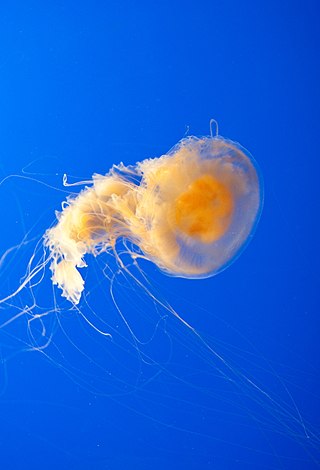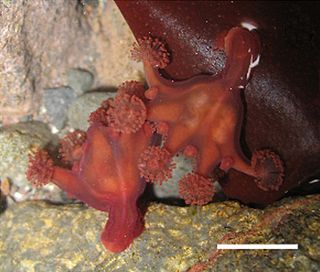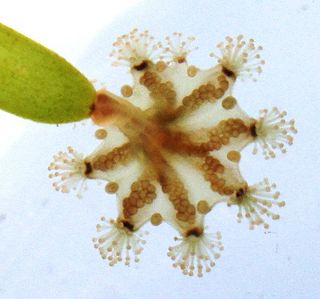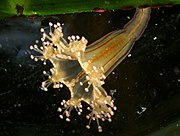
Jellyfish and sea jellies are the common names given to the medusa-phase of certain gelatinous members of the subphylum Medusozoa, which is a major part of the phylum Cnidaria.

The Scyphozoa are an exclusively marine class of the phylum Cnidaria, referred to as the true jellyfish.

Box jellyfish are cnidarian invertebrates distinguished by their box-like body. Some species of box jellyfish produce potent venom delivered by contact with their tentacles. Stings from some species, including Chironex fleckeri, Carukia barnesi, Malo kingi, and a few others, are extremely painful and often fatal to humans.

Aurelia aurita is a species of the family Ulmaridae. All species in the genus are very similar, and it is difficult to identify Aurelia medusae without genetic sampling; most of what follows applies equally to all species of the genus.

Medusozoa is a clade in the phylum Cnidaria, and is often considered a subphylum. It includes the classes Hydrozoa, Scyphozoa, Staurozoa and Cubozoa, and possibly the parasitic Polypodiozoa. Medusozoans are distinguished by having a medusa stage in their often complex life cycle, a medusa typically being an umbrella-shaped body with stinging tentacles around the edge. With the exception of some Hydrozoa, all are called jellyfish in their free-swimming medusa phase.

Stauromedusae are the stalked jellyfishes. They are the sole living members of the class Staurozoa and belong to the medusozoa subphylum of Cnidaria. They are unique among medusa jellyfish in that they do not have an alternation of polyp and medusa life cycle phases, but are instead interpreted as an attached medusa stage, with a lifestyle more resembling that of polypoid forms. They have a generally trumpet-shaped body, oriented upside-down in comparison with other jellyfish, with the tentacles projecting upwards, and the stalk located in the centre of the umbrella.

Staurozoa is a class of Medusozoa, jellyfishes and hydrozoans. It has one extant order: Stauromedusae with a total of 50 known species. A fossil group called Conulariida has been proposed as a second order, although this is highly speculative. The extinct order is largely unknown and described as a possibly cnidarian clade of marine life with shell-like structures, the Conulariida. Staurozoans are small animals that live in marine environments, usually attached to seaweeds, rocks, or gravel. They have a large antitropical distribution, a majority found in boreal or polar, near-shore, and shallow waters. Few staurozoans are found in warmer tropical and subtropical water environments of the Atlantic, Indian, and Pacific Ocean basins, but most are known from the Northern Hemisphere. Over the years the number of discovered species has increased, with an estimated 50 species currently recognized. Information on Staurozoa is sparse, and it is one of the least studied groups within Cnidaria. While often neglected, correctly recognizing the characteristics of this class is crucial for understanding cnidarian evolution.

Phacellophora camtschatica, commonly known as the fried egg jellyfish or egg-yolk jellyfish, is a very large jellyfish in the family Phacellophoridae. This species can be easily identified by the yellow coloration in the center of its body which closely resembles an egg yolk, hence how it got its common name. Some individuals can have a bell close to 60 cm (2 ft) in diameter, and most individuals have 16 clusters of up to a few dozen tentacles, each up to 6 m (20 ft) long. A smaller jellyfish, Cotylorhiza tuberculata, typically found in warmer water, particularly in the Mediterranean Sea, is also popularly called a fried egg jellyfish. Also, P. camtschatica is sometimes confused with the Lion's mane jellyfish.
Calvadosia cruxmelitensis is a stalked jellyfish which inhabits the intertidal and sublittoral zones of rocky coasts in south-western England and the Atlantic coast of Ireland.

Haliclystus is a genus of stalked jellyfish that contains 11 species and one nomen nudum. It is the largest genus in the order Stauromedusae. Members of this genus are found in the Pacific, Atlantic, Indian, Arctic, and Southern oceans. Two members of this genus, Haliclystus kerguelensis and Haliclystus antarcticus, are found in the Southern hemisphere only. The remaining 9 members are found in the Northern hemisphere only.

Haliclystus auricula is a stalked jellyfish found in the Northern hemisphere. It is the type species for its genus.
Lucernaria janetae is an exceptionally large stalked jellyfish discovered on deep-sea hydrothermal vents on the East Pacific Rise in 2003 and described in 2005.

Haliclystus antarcticus is a stalked jellyfish which lives on rocky shore lines in the Southern hemisphere.

Haliclystidae is a family of stalked jellyfish in the order Stauromedusae.
Kyopoda is a genus of stalked jellyfish, It has only one species in the genus, Kyopoda lamberti, and is in turn the only genus in the family Kyopodiidiae.

Haliclystus octoradiatus, common name spotted kaleidoscope jellyfish, is a stalked jellyfish in the family Lucernariidae.

Morbakka virulenta is a species of box jellyfish that is found in waters near the islands of Japan. The species was originally described in the genus Tamoya by Kamakichi Kishinouye in 1910. However, unlike other species of that genus, this jellyfish did not have the vertical gastric phacellae which protect the inside of the bell with nematocyst warts. As a result, it was reclassified to the genus Morbakka due to its distinctively shaped rhopaliar horns which resemble rabbit ears. Because of its painful stings, M. virulenta has been nicknamed Hikurage, which is “fire jellyfish” in Japanese.
Manania gwilliami is a species of stalked jellyfish found in intertidal and subtidal zones on the west coast of North America. The stalk (peduncle) is described as being as long or longer than the calyx; the calyx typically has mottled pigmentation throughout. The name "gwilliami" refers to G.F. Gwilliam who described a number of stauromedusae in the mid-20th century.

Haliclystus sanjuanensis is a species of small (~4 cm) stalked jellyfish found in the Pacific Ocean along the west coast of North America. This species can be found in shallow waters at low tide on soft substrates such as seagrass (Phyllospadix). A variety of colour morphs can be found ranging from yellow-green to red. Haliclystus sanjuanensis was formally described as a distinct species in 2023, following sequence data establishing it as a distinct taxon.
Halimocyathus is a genus of stalked jellyfish in the family Haliclystidae. It is monotypic, containing the sole species Halimocyathus platypus.

















